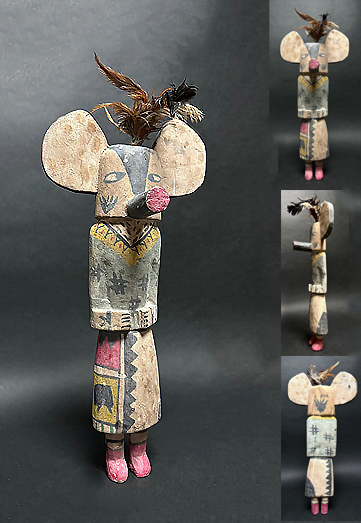
Owner: HWMC
Catalogue #: 2NA-OTHR-117
Ritual Symbolism
Hopi 'Mouse' Kachina
Arizona
Southwest / Hopi
Cotton wood, pigment, feathers
ca. Late 19th – Early 20th century
Height; 17.3 in; Width: 7.8 in; Depth: 3.9 in
Other – Ritual Symbolism
This Hopi doll is known as the ‘Tusan Homichi’ mouse kachina and is considered a great hero to the Second Mesa people. The Hopi recognize three classifications of kachinas: The gods themselves; the costumed impersonators in dances; and carved figures as instructional kachinas for children. Thus, this is not a sacred kachina, but a teaching aid (not toy) to share the legend of the mouse hero who helped rid the village of a pesky hawk who was killing their chickens.
The art of carving Kachina dolls has evolved from this old-style blocklike figure into today’s highly detailed, all-wood dolls with realistic form and action. All Kachina dolls are carved out of the root of the Cottonwood tree. The Cottonwood tree’s vigorous roots travel far and deep in search of water that has a spiritual meaning to the Hopis, as they are dry dirt farmers and the search for water is of crucial importance to their culture.
